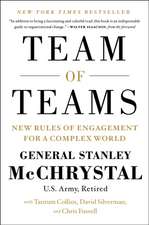Leadership in Chaordic Organizations: Complex and Enterprise Systems Engineering, cartea 6
Autor Beverly G. McCarter, Brian E. Whiteen Limba Engleză Hardback – 18 oct 2012
The book considers the dynamic variables inherent in the human condition and how they impact group dynamics. Helping you to demystify complex system behaviors, it details an approach to leadership that integrates elements of neurobiology, systems engineering, complexity science, philosophy, and evolutionary and social psychology. It defines complexity and its impact on the organization and also explains how conflict can actually be constructive in group settings. Sharing helpful tips on how to build trust in today’s environment, the book also:
- Describes how the human condition affects group dynamics
- Lays out current problems and outlines workable solutions
- Shares a new vision of high-performance teams
- Illuminates theory with applications
Preț: 533.48 lei
Preț vechi: 627.63 lei
-15% Nou
Puncte Express: 800
Preț estimativ în valută:
102.10€ • 106.19$ • 84.28£
102.10€ • 106.19$ • 84.28£
Carte tipărită la comandă
Livrare economică 14-28 aprilie
Preluare comenzi: 021 569.72.76
Specificații
ISBN-13: 9781420074178
ISBN-10: 1420074172
Pagini: 311
Ilustrații: 21 b/w images and 2 tables
Dimensiuni: 157 x 234 x 23 mm
Greutate: 0.59 kg
Ediția:New.
Editura: Auerbach Publications
Seria Complex and Enterprise Systems Engineering
ISBN-10: 1420074172
Pagini: 311
Ilustrații: 21 b/w images and 2 tables
Dimensiuni: 157 x 234 x 23 mm
Greutate: 0.59 kg
Ediția:New.
Editura: Auerbach Publications
Seria Complex and Enterprise Systems Engineering
Public țintă
Systems engineers, managers in scientific and non-scientific environments, managers in industrial and non-profit organizations, organizational development specialists, organizational coaches, and counseling psychologists. Academic researchers in and teachers of complexity theory, complex systems, and complex systems engineering. Architects and designers of 3D immersive learning environments/virtual worlds, teachers and trainers using 3D immersive learning environments/virtual worlds, cultural trainers, group facilitators. Military simulations and training designers, State Department simulation designers, and Enterprise leadership development programs.Cuprins
Definition of Complexity and Its Impact on Organizations; B. E. White
Definition of Complexity
Complex System Behaviors
Surprising Emergence
Evolves on Its Own as a Whole
Acts Robustly
Thrives on Diversity
Many Factors at Play
Stimulates Different Perspectives
Ever Changing
Informs the Observer
Performs Openly
Internal and External Relationships Are Key
Self-Organized
Sensitive to Small Effects
Exhibits Tight and Loose Couplings
Complex Systems Engineering Principles
Bring Humility
Follow Holism
Achieve Balance
Utilize Trans-Disciplines
Embrace POET (Political, Operational, Economic, and Technical) Aspects
Nurture Discussions
Pursue Opportunities
Formulate Heuristics
Foster Trust
Create an Interactive Environment
Stimulate Self-Organization
Seek Simple Elements
Enforce Layered Architecture
Human Behavior
Impact on Organizations
Overarching Fragility Concern
Recognize That Complex Systems Can Do Better than We Can
The Nature of Being Human; B. G. McCarter
Mind and the Brain: An Overview
Basics of the Brain
Mind, Body, and Environment Interaction
The Mind and Emergence
Images and Knowledge: What Is Reality?
Innate Dispositions for Survival
Beyond the Non-Conscious
Emotions
Reason and Decision Making
Synopsis
How to Build Trust; B. E. White and B. G. McCarter
Perspectives on Trust
World Politics, Religions, and Fear
Biases of Individuals, Groups, and Organizations
Learning in Organizations
Storytelling
Perceptions of Reality and Power
Applying Laws of Power and Getting Inside
Types of Trust
Persistent Trust
How Your Emotions May Affect Your Trust
Interpersonal Trust When Not Face to Face
Trust and Inter-Reality Systems
Trust in Mental Health
Trusting with Limited Interpersonal Contact
Implications for Leadership
Recapitulation
Collective Group Dynamics: A New View of High-Performance Teams; B. E. White
Introduction
Characteristics of Traditional Teams
Enneagram©
Cynefin Framework
Examples and Level of Commitment
Behaviors
Distributed Team Models
Serious Games/Virtual Worlds for Training
Difficulties in Distributed Environments
X-Teams
Exploration of Dissenting Individual Mindsets
Program/Project Management
Information Sharing
Guilds
Organizational Learning
Implications for Leadership in Chaordic Organizations
Summary
Takeaways
Application of Theory; B. G. McCarter
Complex Adaptive Systems: A Reprise of Previous Chapters
Conflict
Process Enneagram©
Change
How to Facilitate Change in Organizations
Counseling Skills and Techniques
Specific Techniques
Core Values
Ground Rules
Evaluating Group Processes
Social Systems
The Individual
Changing Our Behaviors
Views of Reality
Human Systems:—What Makes Them Complex
Today’s Problems Come from Yesterday’s Solutions
The Harder You Push, the Harder the System Pushes Back
Behavior Grows Better before It Gets Worse
The Easy Way Out Usually Leads Back In
Faster Is Slower
Cause and Effect Are Not Closely Related in Time and Space
Small Changes Can Produce Big Results, but the Areas of Highest Leverage Are Often the Least Obvious
Dividing an Elephant in Half Does Not Produce Two Elephants
There Is No Blame
Summary
Wicked Problems and MUVEs: Understanding Human Interactions through Multiuser Virtual Environments; B. G. McCarter
Dynamics of Living Human Systems at Work
Psychology of Virtual Worlds
Next Level of Interaction and Learning
Narrative Structures and the Underlying Psychological Dynamics
Appendices:
Mini-Lexicon of Selected Terms
INCOSE Working Group Sidebar on Complex Systems
Quotations from The 48 Laws of Power
Research for Virtual Worlds’ Promotion of Oxytocin
On the Information Explosion
On the Deeper Impact of Virtual Worlds
Web Collaboration, Workspace, Blog Platforms
References
Bibliography
Index
Definition of Complexity
Complex System Behaviors
Surprising Emergence
Evolves on Its Own as a Whole
Acts Robustly
Thrives on Diversity
Many Factors at Play
Stimulates Different Perspectives
Ever Changing
Informs the Observer
Performs Openly
Internal and External Relationships Are Key
Self-Organized
Sensitive to Small Effects
Exhibits Tight and Loose Couplings
Complex Systems Engineering Principles
Bring Humility
Follow Holism
Achieve Balance
Utilize Trans-Disciplines
Embrace POET (Political, Operational, Economic, and Technical) Aspects
Nurture Discussions
Pursue Opportunities
Formulate Heuristics
Foster Trust
Create an Interactive Environment
Stimulate Self-Organization
Seek Simple Elements
Enforce Layered Architecture
Human Behavior
Impact on Organizations
Overarching Fragility Concern
Recognize That Complex Systems Can Do Better than We Can
The Nature of Being Human; B. G. McCarter
Mind and the Brain: An Overview
Basics of the Brain
Mind, Body, and Environment Interaction
The Mind and Emergence
Images and Knowledge: What Is Reality?
Innate Dispositions for Survival
Beyond the Non-Conscious
Emotions
Reason and Decision Making
Synopsis
How to Build Trust; B. E. White and B. G. McCarter
Perspectives on Trust
World Politics, Religions, and Fear
Biases of Individuals, Groups, and Organizations
Learning in Organizations
Storytelling
Perceptions of Reality and Power
Applying Laws of Power and Getting Inside
Types of Trust
Persistent Trust
How Your Emotions May Affect Your Trust
Interpersonal Trust When Not Face to Face
Trust and Inter-Reality Systems
Trust in Mental Health
Trusting with Limited Interpersonal Contact
Implications for Leadership
Recapitulation
Collective Group Dynamics: A New View of High-Performance Teams; B. E. White
Introduction
Characteristics of Traditional Teams
Enneagram©
Cynefin Framework
Examples and Level of Commitment
Behaviors
Distributed Team Models
Serious Games/Virtual Worlds for Training
Difficulties in Distributed Environments
X-Teams
Exploration of Dissenting Individual Mindsets
Program/Project Management
Information Sharing
Guilds
Organizational Learning
Implications for Leadership in Chaordic Organizations
Summary
Takeaways
Application of Theory; B. G. McCarter
Complex Adaptive Systems: A Reprise of Previous Chapters
Conflict
Process Enneagram©
Change
How to Facilitate Change in Organizations
Counseling Skills and Techniques
Specific Techniques
Core Values
Ground Rules
Evaluating Group Processes
Social Systems
The Individual
Changing Our Behaviors
Views of Reality
Human Systems:—What Makes Them Complex
Today’s Problems Come from Yesterday’s Solutions
The Harder You Push, the Harder the System Pushes Back
Behavior Grows Better before It Gets Worse
The Easy Way Out Usually Leads Back In
Faster Is Slower
Cause and Effect Are Not Closely Related in Time and Space
Small Changes Can Produce Big Results, but the Areas of Highest Leverage Are Often the Least Obvious
Dividing an Elephant in Half Does Not Produce Two Elephants
There Is No Blame
Summary
Wicked Problems and MUVEs: Understanding Human Interactions through Multiuser Virtual Environments; B. G. McCarter
Dynamics of Living Human Systems at Work
Psychology of Virtual Worlds
Next Level of Interaction and Learning
Narrative Structures and the Underlying Psychological Dynamics
Appendices:
Mini-Lexicon of Selected Terms
INCOSE Working Group Sidebar on Complex Systems
Quotations from The 48 Laws of Power
Research for Virtual Worlds’ Promotion of Oxytocin
On the Information Explosion
On the Deeper Impact of Virtual Worlds
Web Collaboration, Workspace, Blog Platforms
References
Bibliography
Index
Recenzii
For this book, Beverly Gay McCarter, and Brian E. White have gathered, organized, and interpreted an immense amount of information. They bring together the thinking from chaos and complexity theory, psychology, neuro-linguistic programming, and neuroscience, helping readers better understand the nature and challenges of leadership … .
—Richard N. Knowles, Principal and Organizational Anthropologist, Richard N. Knowles & Associates, Inc., Youngstown, New York
For this book, Beverly Gay McCarter, and Brian E. White have gathered, organized, and interpreted an immense amount of information. They bring together the thinking from chaos and complexity theory, psychology, neuro-linguistic programming, and neuroscience, helping readers better understand the nature and challenges of leadership ... . -Richard N. Knowles, Principal and Organizational Anthropologist, Richard N. Knowles & Associates, Inc., Youngstown, New York
—Richard N. Knowles, Principal and Organizational Anthropologist, Richard N. Knowles & Associates, Inc., Youngstown, New York
For this book, Beverly Gay McCarter, and Brian E. White have gathered, organized, and interpreted an immense amount of information. They bring together the thinking from chaos and complexity theory, psychology, neuro-linguistic programming, and neuroscience, helping readers better understand the nature and challenges of leadership ... . -Richard N. Knowles, Principal and Organizational Anthropologist, Richard N. Knowles & Associates, Inc., Youngstown, New York
Notă biografică
Beverly Gay McCarter is an award-winning architect of immersive virtual environments whose company, Human Mosaic Systems (www.HumanMosiacSystems.com), is located in Cary, North Carolina (Research Triangle Park). She received her MS degree in counseling psychology and human systems from Florida State University and her MFA in studio art from the Memphis College of Art. She is also certified in the areas of facilitating self-organizing systems for complex environments (the Center for Self-Organizing Leadership) and the design and architecture of virtual worlds (University of Washington).
While working as an independent contractor at the National Defense University in Washington, DC, she instructed faculty and Pentagon leadership in the navigation and use of virtual worlds, in addition to coordinating and executing the efforts of the Federal Consortium for Virtual Worlds to bring the federal government into virtual worlds. McCarter is an architect/designer of 3D immersive virtual environments focusing on the psychology of the avatar and virtual worlds, the inherent complex dynamics involved, as well as the impact of the aesthetics of 3D immersive environments on complex human systems. She has advised the Pentagon virtual simulation teams, a solution provider for Linden Labs’ Second Life virtual world, and currently works in a variety of other immersive virtual platforms. As a facilitator, McCarter has worked with the Smithsonian Institution in Washington, DC, among others, facilitating group discussions untangling the "wicked problems" of social interactions that overwhelm today’s organizational structures.
McCarter is an award-winning artist, focusing on human dynamics and the inherent effects of complexity and the edge-of-chaos on human consciousness. Her work emphasizes the ability to "see" multiple perspectives and the complexity of who we are, and our relationships with others.
Through the integration of these areas of expertise, McCarter designs powerful immersive environments that enable self-organization and collaboration as well as a deeper understanding about one’s own perspectives or views of reality and those of others. She architects environments that understand the underlying complex human dynamics and help facilitate the building of relationships, bonding, and greater understanding, all of which help individuals collaborate as they make decisions in complex, ever-changing environments.
A sample of videos that expand more on McCarter’s work can be found at the following link: http://www.humanmosaicsystems.com/page1.php.
Relevant publications and presentations by McCarter include:
White strives to help people change or improve their mindsets by communicating complex systems behaviors and complex systems engineering research knowledge, precepts, and principles where people (particularly stakeholders) are considered part of a system, system of systems, enterprise, or complex system. He accomplishes this by drawing on his twenty-eight years of experience working with corporate executives, middle managers, project leaders, technical staff, and academic colleagues in areas of complexity theory, complex systems, and complex systems engineering.
A summary of Dr. White’s professional activities in recent years follows:
While working as an independent contractor at the National Defense University in Washington, DC, she instructed faculty and Pentagon leadership in the navigation and use of virtual worlds, in addition to coordinating and executing the efforts of the Federal Consortium for Virtual Worlds to bring the federal government into virtual worlds. McCarter is an architect/designer of 3D immersive virtual environments focusing on the psychology of the avatar and virtual worlds, the inherent complex dynamics involved, as well as the impact of the aesthetics of 3D immersive environments on complex human systems. She has advised the Pentagon virtual simulation teams, a solution provider for Linden Labs’ Second Life virtual world, and currently works in a variety of other immersive virtual platforms. As a facilitator, McCarter has worked with the Smithsonian Institution in Washington, DC, among others, facilitating group discussions untangling the "wicked problems" of social interactions that overwhelm today’s organizational structures.
McCarter is an award-winning artist, focusing on human dynamics and the inherent effects of complexity and the edge-of-chaos on human consciousness. Her work emphasizes the ability to "see" multiple perspectives and the complexity of who we are, and our relationships with others.
Through the integration of these areas of expertise, McCarter designs powerful immersive environments that enable self-organization and collaboration as well as a deeper understanding about one’s own perspectives or views of reality and those of others. She architects environments that understand the underlying complex human dynamics and help facilitate the building of relationships, bonding, and greater understanding, all of which help individuals collaborate as they make decisions in complex, ever-changing environments.
A sample of videos that expand more on McCarter’s work can be found at the following link: http://www.humanmosaicsystems.com/page1.php.
Relevant publications and presentations by McCarter include:
- Lowell F. Christy, Jr., and Beverly G. McCarter. "Why Whole Systems Thinking Is Moving Beyond Engineering Backwaters." George Washington University. Research Program in Social and Organizational Learning. Washington, DC. January 29, 2008
- B. G. McCarter, "Federal Virtual World Challenge: Description, Results and Discussion," Federal Consortium for Virtual Worlds, Washington, DC, May 16, 2012.
- B. G. McCarter, "Immersive Intelligence and 3D Data Visualization," Federal Consortium for Virtual Worlds, Washington, DC, May 16, 2012.
- B. G. McCarter, "Narrative Structures, Wicked Problems, and MUVEs," East Coast Gaming Conference, Raleigh, NC, April 25ߝ26, 2012.
- B. G. McCarter, "Federal Virtual World Challenge: Winner Demonstrations," GameTech Users’ Conference, Orlando, FL, March 28ߝ30, 2012.
- B. G. McCarter. "Designing and Facilitating for Living Human Systems: Wicked Problems and MUVEs." Second Life Community Convention. Oakland, CA. August 14, 2011.
- B. G. McCarter. "Walking across Government Silos: The Power of Virtual Worlds." FISSEA. Washington, DC. March 25, 2010.
- B. G. McCarter. "Center for Naval Intelligence: Virtual World Overview." Center for Naval Intelligence. Virginia Beach, VA. March 23, 2010.
- B. G. McCarter. "Reaching across Organizations with Virtual Worlds." Social Media for Government. Washington, DC. March 12, 2010.
- B. G. McCarter. "Virtual Simulations and Decision Making." Innovative Decisions, Inc. Vienna, VA. May 2009.
- B. G. McCarter. "Complex Human Systems: Paradigm Shifts through Immersive Virtual Environments." United Nations Climate Change Conference (COP15). Virtual World: Second Life. December 9, 2009.
- B. G. McCarter. "Complex Human Systems and Immersive Virtual Environments." 2nd Louisiana Conference on Virtual Worlds and Higher Learning. Virtual World: Second Life. November 2009.
- B. G. McCarter. "Social Aspects of Complexity: 21st Century Dynamics." Applied Systems Thinking Institute. Washington, DC. September 2009.
- B. G. McCarter. "Social Aspects of Complexity: Self-Organizational Dynamics." 2008 Understanding Complex Systems Symposium. University of Illinois at Urbana-Champaign. May 2008.
- B. G. McCarter. "Complexity and Managing Change in Organizations." George Washington University
- Research Program in Social and Organizational Learning. Washington, DC. March 2008.
- Beverly G. McCarter. "Social Aspects of Complexity." MITRE (Boston, MA, McLean, VA, and Chantilly, VA). International Council on Systems Engineering New England Chapter (Boston, MA). March 12, 2008.
- B. G. McCarter and B. E. White. "Emergence of SoS, Socio-Cognitive Aspects." In System of Systems Engineering—Principles and Applications, edited by M. Jamshidi. Boca Raton: CRC Press. 2009.
- B. G. McCarter and B. E. White. "Collaboration/Cooperation in Sharing and Utilizing Net-Centric Information." 5th Annual Conference on Systems Engineering Research. March 2007.
- William D. Miller, Gay McCarter, and Craig O. Hayenga. "Modeling Organizational Dynamics." IEEE International Conference on Systems Engineering. SMC. Los Angeles, CA. April 2006.
- "A Mosaic for Jackson." Southern Living Magazine. February 2002.
- Featured artist in Mosaic Techniques & Traditions: Projects and Designs from Around the World. Compiled by Sonia King. New York: Sterling Publications, September 2002.
- Mosaic Matters International Online Magazine. November 2001.
- Tennessee Arts Commission Magazine. December 2000.
- Jackson Chamber of Commerce Magazine. December 2000.
- Public Art Commission. Jackson and the Arts: An Outdoor Mosaic Wall Mural. Ned McWherter West Tennessee Cultural Arts Center. Jackson, TN. 2000.
- Book cover for Social Welfare: A World View. By Katherine Van Wormer. Chicago: Nelson-Hall, 1997.
White strives to help people change or improve their mindsets by communicating complex systems behaviors and complex systems engineering research knowledge, precepts, and principles where people (particularly stakeholders) are considered part of a system, system of systems, enterprise, or complex system. He accomplishes this by drawing on his twenty-eight years of experience working with corporate executives, middle managers, project leaders, technical staff, and academic colleagues in areas of complexity theory, complex systems, and complex systems engineering.
A summary of Dr. White’s professional activities in recent years follows:
- 2010ߝ2011: International Council on Systems Engineering (INCOSE)
- Presented tutorial on Principles of Complex Systems Engineering at INCOSE Symposium 2011 (June 2011), INCOSE Washington (DC) Metropolitan Area Chapter (August 2011)
- Rejoined INCOSE as senior member in July 2010. For INCOSE Symposium 2010, was invited to be on two panels (architecture and cyber-security)
- Presented his 2010 IEEE International Systems Conference paper in the IEEE session
- Chaired the above session and a complex systems session
- 2006ߝpresent: Co-editor of a MITRE book series, Complex and Enterprise Systems Engineering, with Taylor & Francis.
- Co-author of chapter: "Emergence of SoS, Socio-Cognitive Aspects." In System of Systems Engineering—Principles and Applications. Boca Raton, FL: CRC Press, 2009.
- Co-editor and chapter author: "Enterprise Opportunity and Risk." In Enterprise Systems Engineering: Advances in the Theory and Practice. Boca Raton, FL: CRC Press, 2011.
- Co-editor of book: Case Studies in System of Systems, Enterprises, and Complex Systems Engineering. Expected publication date: late 2013.
- 2005ߝpresent: Authored and presented more than twenty conference papers in complex systems engineering. Selected citations:
- B. E. White. "Managing Uncertainty in Dating and Other Complex Systems." Conference on Systems Engineering Research (CSER). Redondo Beach, CA, April 15ߝ16, 2011.
- B. E. White and P. N. Jean. "Case Study in System of Systems Engineering: NASA’s Advanced Communications Technology Satellite." 6th IEEE International Conference on System of Systems Engineering (SoSE 2011). Albuquerque, New Mexico. June 27ߝ30, 2011.
- B. E. White. "Let’s Do Better in Limiting Material Growth to Conserve Our Earth’s Resources."
- Conference on Systems Engineering Research (CSER). St Louis, MO. March 19ߝ22, 2012.
- B. E. White et al. "Application of Case Studies to Engineering Management and Systems Engineering Education." Annual Conference, American Society of Engineering Education. San Antonio, TX. June 10ߝ13, 2012.
- B. E. White. "Systems Engineering Decision Making May Be More Emotional than Rational." Annual INCOSE International Symposium. Rome, Italy, July 9ߝ12, 2012.
- 2003ߝpresent: Further developed and augmented MITRE’s "Regimen for Complex Systems Engineering" to create what is now called the Complex Adaptive Systems Engineering (CASE) methodology.
- Developed case studies showing the degree to which CASE principles are followed in important government programs such as maritime domain awareness and Census Bureau information processing.






















